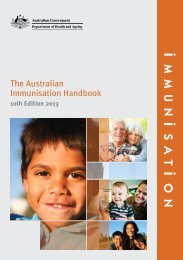English - pdf - 1234 Kb - Malaysian Paediatric Association
English - pdf - 1234 Kb - Malaysian Paediatric Association
English - pdf - 1234 Kb - Malaysian Paediatric Association
You also want an ePaper? Increase the reach of your titles
YUMPU automatically turns print PDFs into web optimized ePapers that Google loves.
What To Do In An Emergency<br />
• Use ice pack to control swelling<br />
immediately after a fall when there<br />
is no broken skin.<br />
• Observe your baby carefully for<br />
24 hours after a head injury for<br />
behavioural changes as above<br />
• If your child is unable to move<br />
the injured part, use a stiff material<br />
(a piece of wood/rolled up<br />
newspaper) to make a splint<br />
(see First Aid Section)<br />
Choking<br />
• When something blocks your<br />
child’s throat, he will cough, gasp<br />
or gag<br />
• If your baby or very young child<br />
cannot make sounds, stops<br />
breathing or turns blue, act quickly<br />
as he may have an obstructed<br />
airway.<br />
• Young children normally choke on<br />
toys with small parts, food or<br />
small items found at home (coins,<br />
buttons, eraser, jewellery, deflated<br />
balloon, etc.)<br />
What To Do In An Emergency<br />
For a small child<br />
• Place your child over your thigh,<br />
head down.<br />
• Slap between the shoulder blades<br />
• If back blows fail, use abdominal<br />
thrusts only if you have been<br />
trained to do so on a child<br />
• If not, begin CPR (see section<br />
on CPR)<br />
For a baby<br />
• Lay the baby in an inclined plane<br />
(e.g. your forearm), with the<br />
head down<br />
• Slap between the shoulder blades,<br />
using less force than for a child<br />
• Repeat until item is dislodged<br />
• If baby becomes unconscious,<br />
begin CPR (see section on CPR)<br />
• DO NOT use abdominal thrusts<br />
Burns & Scalds<br />
• Common sources of scalds: Hot<br />
liquids such as coffee or tea; bottles<br />
that have been heated in a<br />
microwave oven or stove; fire from<br />
a spark or ashes; water heater<br />
temperature (more than 120°F)<br />
• Burns and scalds can range from<br />
mild to serious<br />
a. First-degree burns: Redness and<br />
slight swelling of the skin, affects<br />
only the outer layer of the skin<br />
b. Second-degree burns: Cause<br />
blistering, intense reddening and<br />
moderate to severe swelling and<br />
pain. The top layer of the skin<br />
17
















